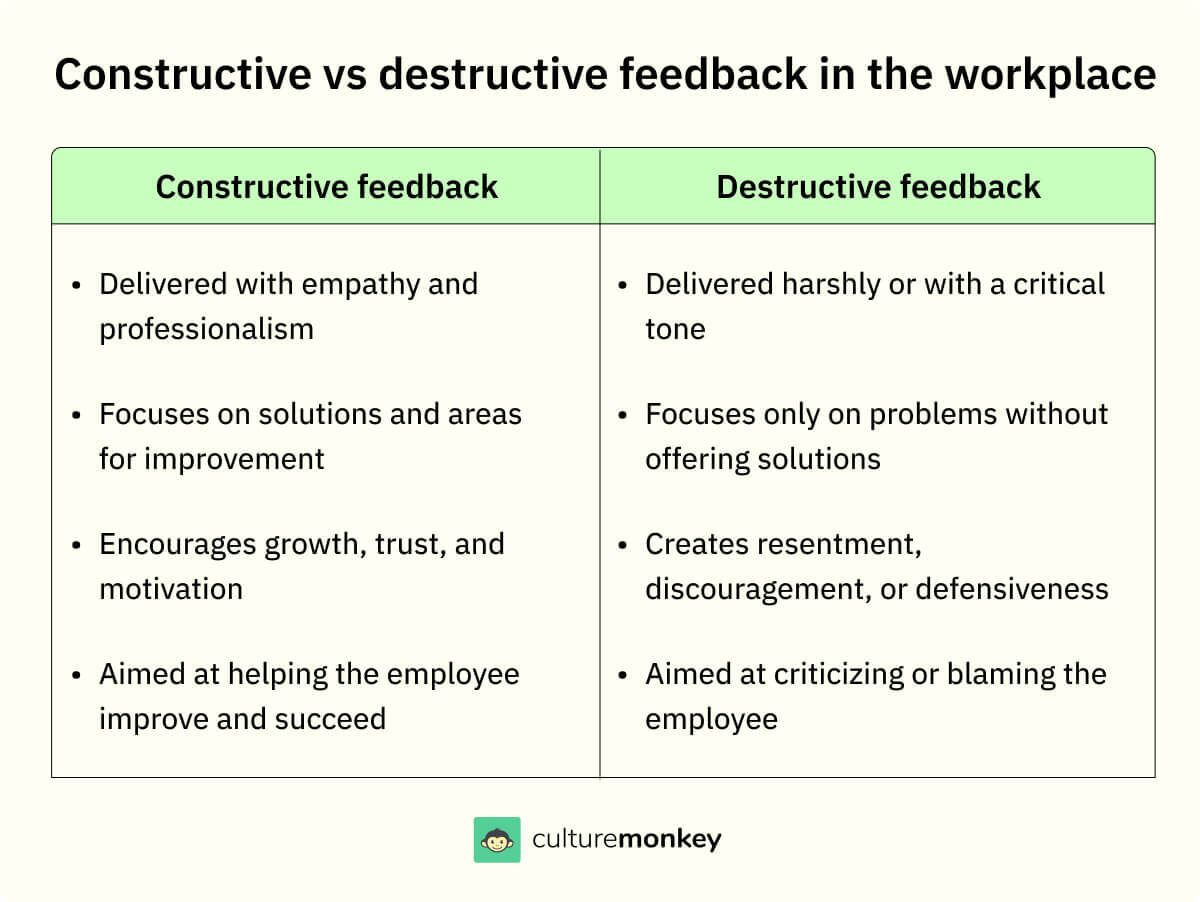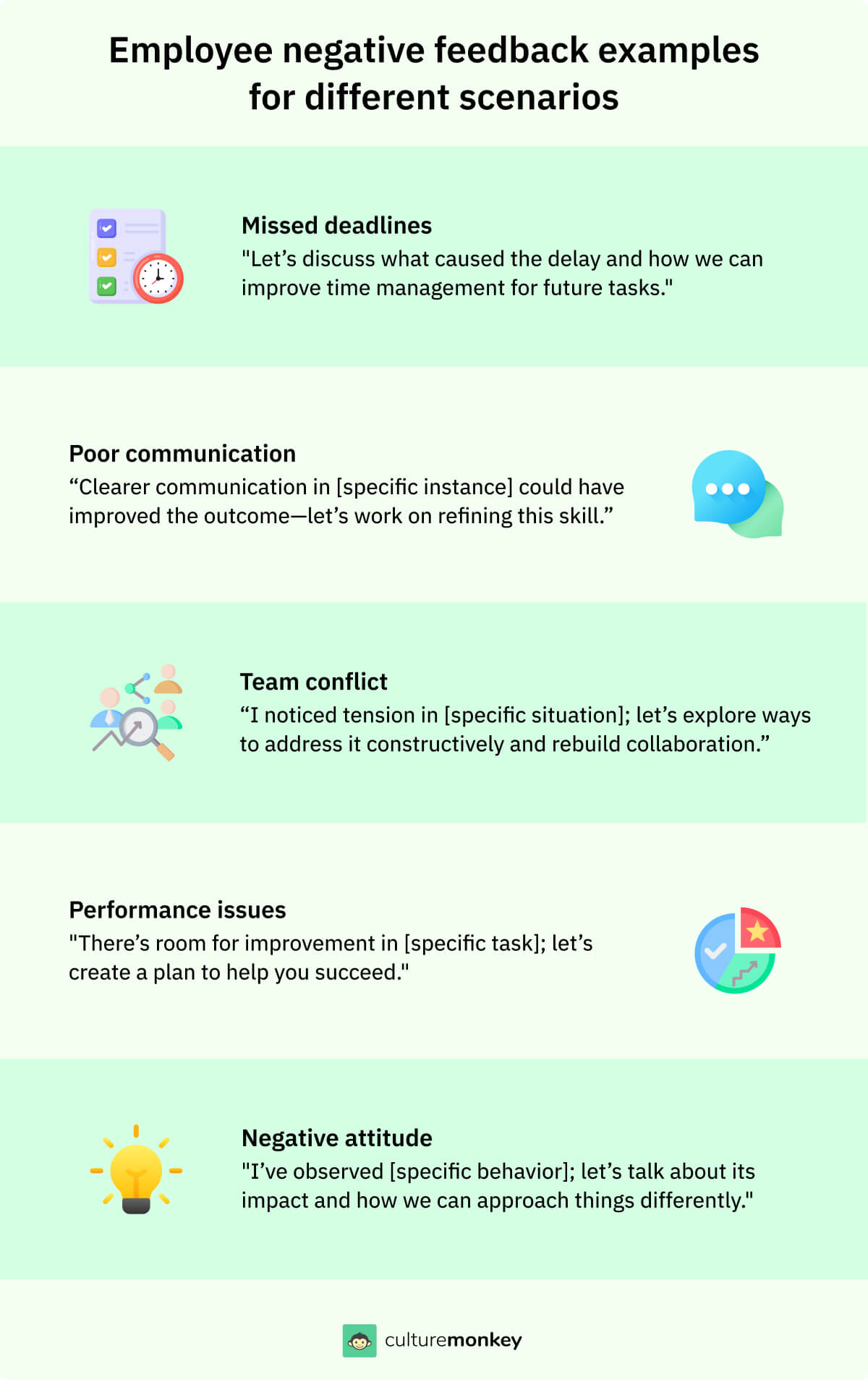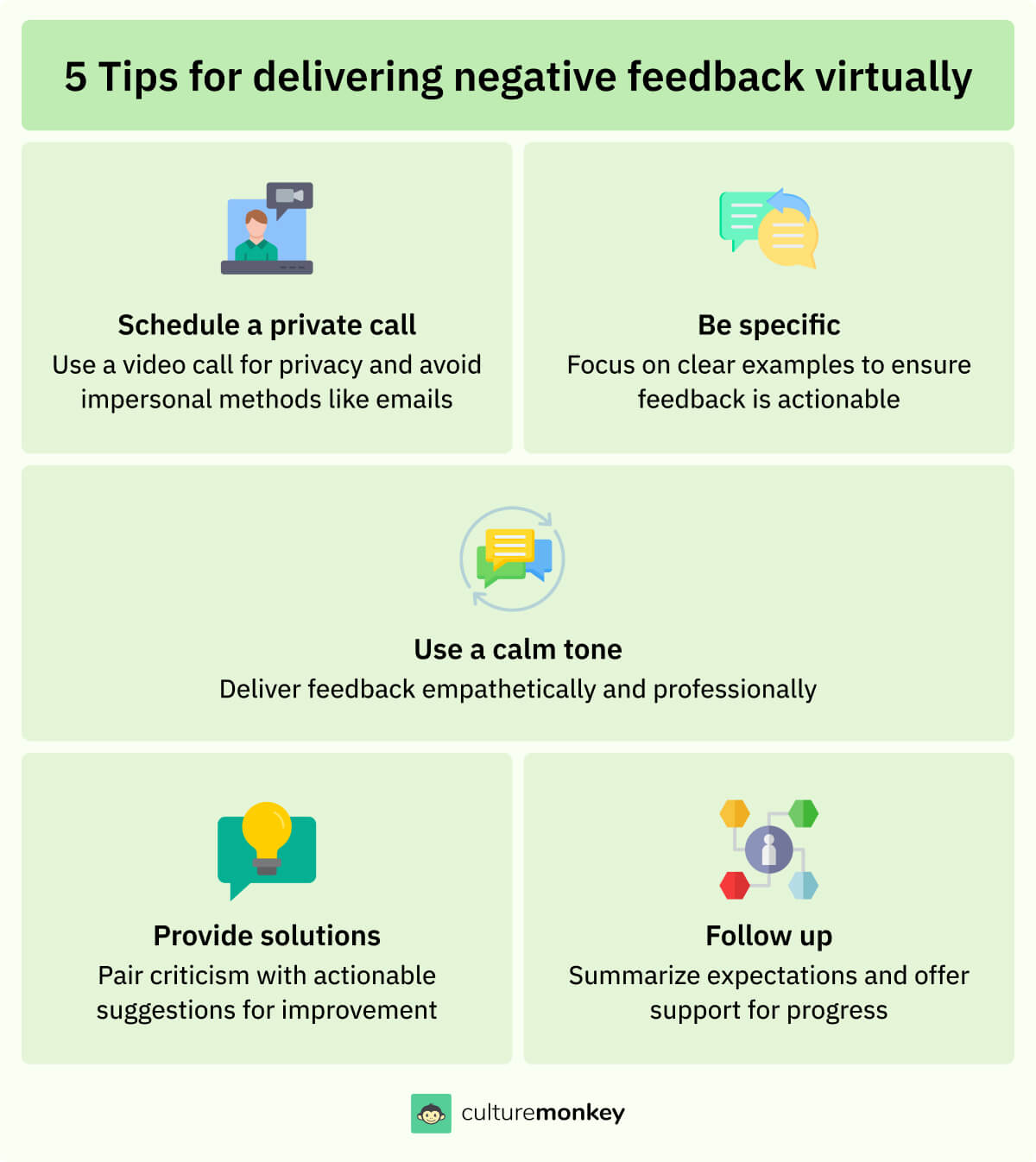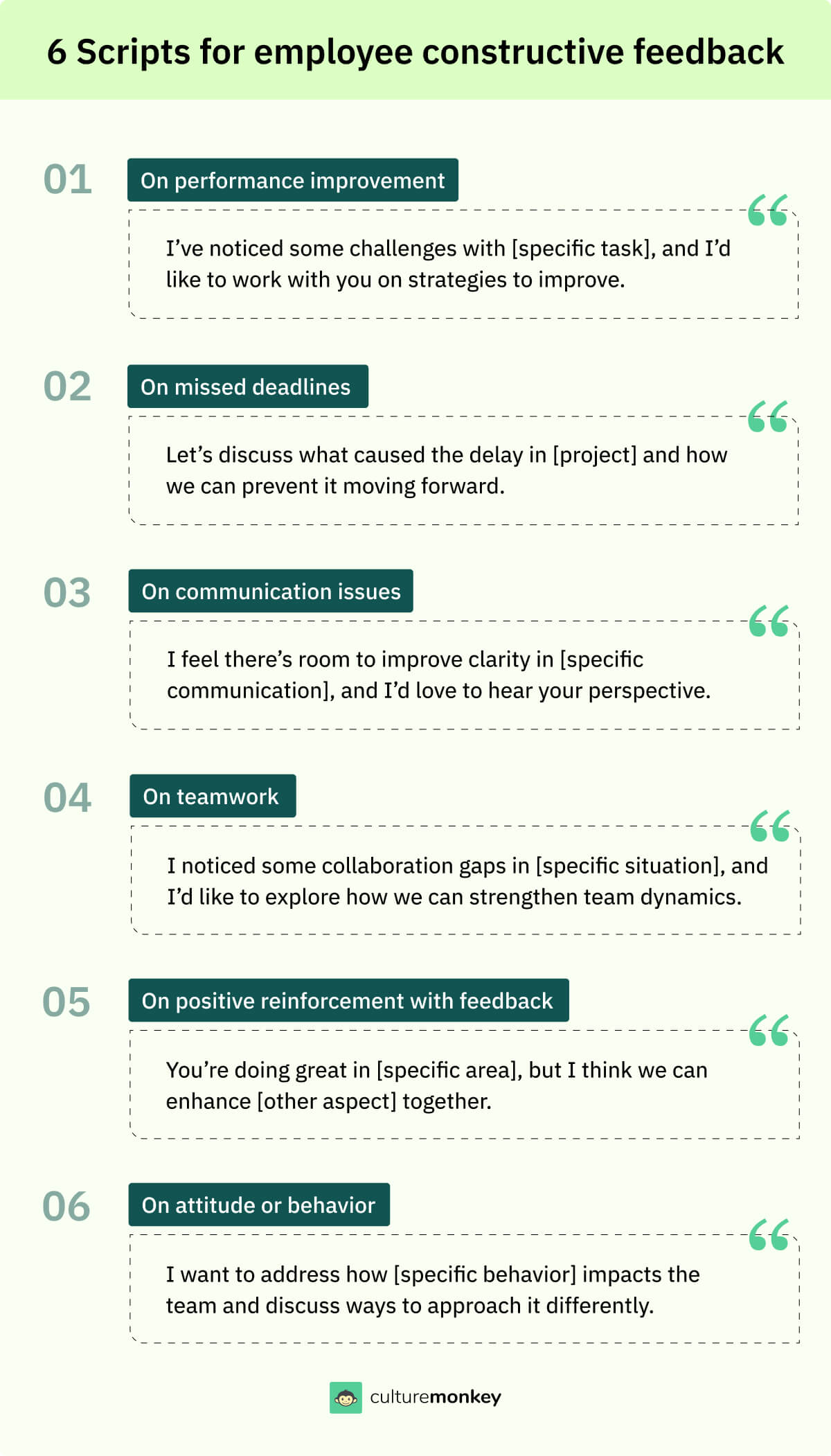75+ Negative feedback examples: Learning and growing from constructive criticism

Ever watched that iconic classic, "The Pursuit of Happyness," where Will Smith's character, Chris Gardner, faces countless rejections while striving for a better life? Remember how those setbacks ultimately propelled him toward success?
Well, just like Chris, we too encounter moments of professional turbulence, often wrapped in the package of effective negative feedback.
Let's face it – no one jumps for joy when they receive constructive criticism, especially from the boss. It can sting like a bee, leaving us momentarily shaken and a tad defensive. But what if I told you that beneath that initial discomfort lies a golden opportunity?
Yes, a negative feedback loop can be a catalyst for personal and career growth, much like Chris Gardner's struggles paved the way for his triumph.
In this blog, we'll delve into real-life negative feedback examples and explore how these moments, akin to Hollywood plot twists, can be the turning point in your professional journey.
TL;DR
What is negative feedback?

TL;DR
Negative feedback is constructive input highlighting areas for improvement, not just criticism. Like a reality check, it guides you to correct mistakes and develop skills, much like resistance strengthens muscles.
Far from being harmful, it’s a growth tool that fosters learning and progress, helping you perform better and achieve more in your professional journey.
Have you ever had that sinking feeling when your boss or colleague approaches you with a furrowed brow, ready to deliver some "constructive criticism"? It's like the ominous music in a horror movie right before the monster jumps out.
But hey, don't worry; negative feedback is not a monster lurking in the office shadows. It's actually a superhero in disguise, here to save the day!
So, what is negative feedback, anyway? Simply put, it's the not-so-glowing input we receive about our performance or actions. It's like a reality check in a world that sometimes seems obsessed with praise and positivity.
Negative feedback serves several vital purposes. First, it points out areas where you can improve. Think of it as your trusty GPS, guiding you away from traffic jams and dead ends. Second, it fosters growth and development.
Remember how muscles get stronger with resistance training? Well, your skills do too, thanks to negative feedback.
What are the four types of negative feedback?

Negative feedback comes in various forms, and understanding these types can help us navigate the complex world of communication and personal development. Let's take a closer look at the four primary types of negative feedback and how they influence our growth and relationships.



Feedback is not just about performance; it’s about development, trust, and mutual respect.
- Evaluative feedback: Evaluative feedback is probably the most familiar type. It involves assessing someone's performance or behavior, often highlighting areas that need improvement. This type of feedback aims to judge and provide a clear sense of where someone stands.
- Directive feedback: Directive feedback takes a more prescriptive approach. It not only identifies the issue but also suggests specific actions or solutions for improvement. It provides clear guidance on what steps to take.
- Expert feedback: Expert feedback draws upon the experience and knowledge of the person providing the feedback. It's particularly useful when someone seeks advice or guidance in a specific area where the giver of feedback has expertise.
- Coaching feedback: Coaching feedback is about fostering personal growth and development. It often involves a more collaborative approach, focusing on exploring options, setting goals, and working together to achieve them.
75+ Negative employee feedback examples

Employers often find themselves tiptoeing around, fearing that addressing the issues might lead to a demotivated workforce or even resignations. But what if we told you that negative feedback can be the key to unlocking untapped potential in your team when handled correctly?
Let's dive into some examples to demystify the process and reveal how it can become a catalyst for positive change.
TL;DR
Negative feedback, when delivered constructively, addresses performance, behavior, and growth gaps effectively. Examples range from missed deadlines and poor communication to lack of initiative and toxic behavior.
Thoughtful feedback fosters improvement, engagement, and trust by being specific, actionable, and supportive. Used wisely, it transforms challenges into opportunities, helping employees develop skills and contribute meaningfully to team success.
- Missed deadline debacle: John, a usually punctual employee, consistently misses deadlines. Feedback: "John, I’ve noticed recent delays in meeting deadlines, which impacts our team’s efficiency. Let’s discuss challenges you’re facing and work on a plan to ensure timely completions."
- Communication conundrum: Sarah has excellent technical skills but struggles with effective communication. Feedback: "Sarah, your technical skills are top-notch, but clear communication is critical for team success. Let’s explore resources to help improve this skill."
- Feedback-resistant rebel: Michael tends to resist feedback and gets defensive when approached. Feedback: "Michael, feedback is key for growth, and I’d like us to collaborate on ways to make this process more constructive. Your input is valuable to your development."
- Innovation inertia: Emily resists adopting new technologies and methodologies. Feedback: "Emily, innovation is essential in today’s fast-changing environment. Let’s find ways to embrace new tools and ensure your expertise remains impactful."
- Burnout bombshell: Mark’s long hours raise concerns about burnout. Feedback: "Mark, I appreciate your dedication, but I’m concerned about your well-being. Let’s discuss ways to balance your workload and maintain your health."
- Quality quandary: Emma delivers work that lacks quality. Feedback: "Emma, quality is key to our deliverables. Let’s identify areas for improvement and provide you with resources to enhance your work."
- Leadership labyrinth: James struggles with delegation and micromanagement. Feedback: "James, empowering your team is critical for effective leadership. Let’s explore strategies to delegate and build trust in your leadership style."
- Customer care challenge: Linda falls short of meeting customer expectations. Feedback: "Linda, customer satisfaction is vital. Let’s focus on enhancing your service skills with training and support to meet expectations."
- Teamwork trouble: The marketing team struggles with collaboration. Feedback: "Team, effective collaboration is crucial for our success. Let’s address these challenges and foster a culture of open communication."
- Adaptability Achilles’ heel: Alex resists adapting to new technologies and methodologies in a rapidly changing industry. Feedback: "Alex, adaptability is key in our dynamic work environment. Let’s discuss strategies to embrace changes and stay ahead."
- Initiative interruption: Rachel hesitates to take initiative and waits for instructions. Feedback: "Rachel, I’ve noticed you often wait for guidance instead of taking initiative. Let’s work on fostering confidence and autonomy in your approach."
- Conflict conundrum: Mark and Sarah frequently clash, creating tension within the team. Feedback: "Mark, Sarah, I’ve observed conflicts that are affecting team dynamics. Let’s address this openly and find ways to resolve issues for a harmonious environment."
- Growth gap: Jessica, a long-time employee, has plateaued in skills and contributions. Feedback: "Jessica, you have great potential, but I’ve noticed stagnation in your development. Let’s discuss your goals and identify opportunities for growth."
- Client concern: David, a sales representative, receives negative client feedback on his communication style. Feedback: "David, client satisfaction is critical, and I’ve received concerns about your communication. Let’s work on improving this through coaching and resources."
- Time management tangle: Tina struggles with time management, leading to missed deadlines and rushed work. Feedback: "Tina, effective time management is essential to success. Let’s explore strategies and tools to help you stay organized and productive."
- Creativity challenge: Robert, a creative team member, has hit a creative block, impacting quality. Feedback: "Robert, your creativity is valued, but I’ve noticed challenges recently. Let’s discuss any obstacles and brainstorm strategies to reignite your creative flow."
- Technical troubles: Karen, an IT specialist, frequently makes technical errors. Feedback: "Karen, technical accuracy is crucial in your role. Let’s focus on improving this through training and additional support to ensure quality performance."
- Presentation predicament: Tom struggles with public speaking and presentations. Feedback: "Tom, effective communication is vital in our roles, and I’ve noticed challenges in your presentations. Let’s work on enhancing your public speaking skills."
- Sales slip-up: Alex, a salesperson, experiences a decline in performance. Feedback: "Alex, sales are a critical part of your role, and I’ve noticed a dip in results. Let’s explore factors impacting this and develop strategies for improvement."
- Multitasking muddle: Rachel juggles multiple tasks but struggles to complete them effectively. Feedback: "Rachel, I appreciate your enthusiasm, but multitasking is affecting quality. Let’s discuss workload management strategies for better outcomes."
- Communication breakdown: Sarah delays responses to emails and messages, causing communication issues. Feedback: "Sarah, timely communication is crucial for smooth project workflows. Let’s explore ways to improve your responsiveness and keep everyone informed."
- Unprofessional conduct: Michael occasionally exhibits unprofessional behavior in the workplace. Feedback: "Michael, professionalism is essential for our team’s cohesion. Let’s discuss maintaining respectful interactions and address any concerns."
- Attendance dilemma: Emily frequently arrives late, affecting team morale. Feedback: "Emily, punctuality is vital to our workplace efficiency. Let’s discuss the importance of timeliness and find ways to improve this moving forward."
- Accountability aversion: Mark consistently deflects responsibility when errors occur. Feedback: "Mark, accountability is key to teamwork. Let’s emphasize the importance of taking ownership and work on strategies to address this."
- Quality neglect: Linda submits work with numerous errors, impacting project quality. Feedback: "Linda, maintaining quality is critical. Let’s discuss improving attention to detail and strategies to ensure high-quality deliverables."
- Toxic behavior: Jason spreads negativity and demotivates team members. Feedback: "Jason, maintaining a positive team dynamic is essential. Let’s address concerns and focus on fostering a supportive and encouraging work environment."
- Ethical standards violation: Sarah has been involved in questionable ethical decisions. Feedback: "Sarah, our organization values integrity above all else. Let’s address these concerns and ensure alignment with ethical standards moving forward."
- Delegation dilemma: John struggles to delegate tasks effectively, leading to inefficiencies. Feedback: "John, effective delegation empowers your team and improves workflow. Let’s explore strategies to enhance this skill and distribute tasks efficiently."
- Documentation deficiency: David overlooks important documentation, causing issues in project tracking. Feedback: "David, thorough documentation is vital for project success. Let’s discuss strategies to improve record-keeping processes and ensure consistency."
- Cross-functional collaboration challenge: Lisa struggles with collaboration and communication across departments. Feedback: "Lisa, cross-functional collaboration is essential for our success. Let’s work on improving communication and building stronger relationships with colleagues in other departments."
- Decision-making dilemma: Richard hesitates to make independent decisions, seeking constant approval. Feedback: "Richard, decision-making is a key skill, and I’ve noticed hesitation in this area. Let’s work on building your confidence to handle tasks autonomously."
- Technical knowledge gap: Jessica struggles to keep up with the latest industry technologies. Feedback: "Jessica, staying updated is critical in your role. Let’s explore training programs and certifications to help you stay competitive and effective."
- Interpersonal conflicts within the team: Frequent clashes among team members disrupt team cohesion. Feedback: "Team, conflicts are affecting our dynamics. Let’s address these issues openly and work on conflict resolution strategies to maintain harmony."
- Overreliance on supervision: Alex frequently seeks supervision for tasks he can handle independently. Feedback: "Alex, your skills are strong, but I’ve noticed you rely heavily on supervision. Let’s work on fostering independence while maintaining support for complex tasks."
- Peer recognition issue: Mark doesn’t acknowledge colleagues’ contributions effectively. Feedback: "Mark, recognizing peers is vital for team dynamics. Let’s discuss ways to foster appreciation and create a positive work culture."
- Presentation perfection pursuit: Emily prioritizes perfection in presentations, often missing deadlines. Feedback: "Emily, your commitment to quality is commendable, but balancing deadlines is crucial. Let’s discuss strategies to maintain efficiency without compromising quality."
- Project prioritization problem: Sarah struggles to prioritize tasks, causing delays and missed deadlines. Feedback: "Sarah, task prioritization is vital for project success. Let’s explore strategies to organize and manage tasks more effectively."
- Adaptability issue: John resists adapting to sudden changes in project scope or direction. Feedback: "John, adaptability is key in our dynamic environment. Let’s discuss ways to embrace change and remain flexible in shifting circumstances."
- Remote work struggle: Rachel faces challenges with productivity and deadlines while working remotely. Feedback: "Rachel, remote work requires strong discipline. Let’s explore strategies to enhance your routine and meet your goals consistently."
- Follow-through failure: Michael enthusiastically starts projects but struggles to complete them. Feedback: "Michael, follow-through is essential to success. Let’s discuss strategies to maintain momentum and ensure projects are completed successfully."
- Compliance concern: Linda neglects company policies, leading to compliance issues. Feedback: "Linda, adhering to policies is critical. Let’s review these protocols together to ensure understanding and compliance moving forward."
- Knowledge-sharing gap: Emma rarely shares her expertise with the team, limiting collective growth. Feedback: "Emma, your knowledge is a valuable asset. Let’s explore ways to share your expertise and support your colleagues’ development."
- Emotional intelligence issue: James reacts emotionally to stressful situations, impacting team morale. Feedback: "James, managing stress effectively is crucial for maintaining positivity. Let’s work on developing emotional intelligence and stress management skills."
- Performance plateau: Sarah’s performance has stagnated, showing no signs of improvement. Feedback: "Sarah, consistent improvement is essential for growth. Let’s identify areas to develop and set goals to help you progress."
- Confidentiality breach: David shared sensitive information externally, breaching confidentiality. Feedback: "David, confidentiality is critical for our operations. Let’s review policies to ensure understanding and prevent future breaches."
- Mentoring mishap: Alex struggles to effectively guide his mentee in a mentoring role. Feedback: "Alex, mentoring requires patience and guidance. Let’s discuss strategies to improve your approach and better support your mentee."
- Follow-up fail: Tina frequently neglects to follow up on tasks, leading to delays. Feedback: "Tina, follow-ups are vital to keeping projects on track. Let’s explore ways to improve your process and ensure timely progress."
- Skill stagnation: Mark avoids learning opportunities, impacting his performance. Feedback: "Mark, skill development is vital for effectiveness. Let’s discuss your interests and find relevant training to enhance your abilities."
- Innovation aversion: Jessica resists new ideas and approaches, limiting creativity. Feedback: "Jessica, embracing innovation is crucial for growth. Let’s discuss ways to integrate new ideas and encourage creative contributions."
- Trust issue: Karen struggles to build trust within her team, affecting collaboration. Feedback: "Karen, trust is foundational for teamwork. Let’s discuss strategies to strengthen relationships and foster team cohesion."
- Delegation dilemma: Emily struggles with delegating tasks, leading to inefficiencies. Feedback: "Emily, effective delegation empowers your team. Let’s explore strategies to distribute tasks efficiently and enhance productivity."
- Feedback phobia: Robert avoids giving constructive feedback, affecting team development. Feedback: "Robert, providing feedback is vital for growth. Let’s discuss approaches to offer constructive, supportive feedback to your peers."
- Engagement issue: Sarah appears disengaged during team meetings, impacting team morale. Feedback: "Sarah, active participation in meetings is crucial for collaboration. Let’s identify underlying issues and explore ways to increase your involvement."
- Process negligence: Mark frequently bypasses established processes, causing inconsistencies. Feedback: "Mark, following processes ensures quality and consistency. Let’s review their importance and ensure adherence going forward."
- Creativity block: Robert seems creatively blocked, affecting the quality of his work. Feedback: "Robert, your creativity is highly valued. Let’s identify barriers and brainstorm strategies to help you regain your creative spark."
- Procrastination problem: Rachel consistently delays tasks until the last minute. Feedback: "Rachel, procrastination impacts deadlines and quality. Let’s work on techniques to help you manage tasks proactively and stay ahead."
- Resistance to feedback: David struggles to accept feedback constructively, becoming defensive. Feedback: "David, feedback is essential for growth. Let’s discuss ways to make the process constructive and ensure it benefits your development."
- Lack of initiative: Jessica hesitates to take ownership of projects and tasks. Feedback: "Jessica, initiative is key to driving success. Let’s explore ways to build confidence and empower you to take the lead on projects."
- Knowledge retention issue: Karen forgets key details from meetings, causing delays in projects. Feedback: "Karen, retaining and acting on meeting details is critical. Let’s discuss strategies like note-taking to improve follow-through."
- Overcommitment: Alex takes on too many tasks, leading to incomplete work. Feedback: "Alex, your enthusiasm is commendable, but overcommitment affects outcomes. Let’s prioritize tasks and set realistic goals together."
- Toxic behavior: Jason’s actions disrupt team harmony and morale. Feedback: "Jason, a positive environment is vital for success. Let’s address specific concerns and focus on fostering a collaborative, supportive workplace."
- Overambition: Emma sets unrealistic goals, often falling short. Feedback: "Emma, your drive is inspiring, but it’s essential to set achievable targets. Let’s adjust your goals to ensure consistent progress and success."
- Micromanagement tendency: John frequently micromanages tasks, impacting team trust. Feedback: "John, trust is key in leadership. Let’s work on empowering your team through better delegation and support."
- Conflict avoidance: Rachel avoids addressing conflicts, which escalates issues. Feedback: "Rachel, resolving conflicts constructively is essential. Let’s develop strategies to handle disputes effectively and maintain team harmony."
- Emotional reactivity: Michael’s emotional responses during stress impact team productivity. Feedback: "Michael, managing emotions under pressure is crucial. Let’s work on building resilience and improving stress management techniques."
- Skill mismatch: Karen is often assigned tasks outside her expertise, leading to underperformance. Feedback: "Karen, aligning tasks with your skills is vital for success. Let’s discuss reassignments and training opportunities to better suit your strengths."
- Unclear role understanding: Tina struggles with unclear responsibilities, causing inconsistencies. Feedback: "Tina, clarity in roles is crucial. Let’s review your responsibilities and ensure you have a clear understanding of expectations."
- Overreliance on tools: Alex depends too heavily on technology, neglecting manual processes. Feedback: "Alex, tools are valuable, but balance with manual methods is key. Let’s work on integrating flexibility into your workflow."
- Remote work isolation: Jessica feels disconnected while working remotely, impacting engagement. Feedback: "Jessica, maintaining connection is critical in remote work. Let’s explore strategies to improve communication and collaboration."
- Frequent oversights: Mark’s frequent mistakes affect overall project quality. Feedback: "Mark, attention to detail is essential for quality outcomes. Let’s discuss strategies to improve focus and accuracy."
- Lack of peer collaboration: Robert avoids collaborating with teammates, preferring to work alone. Feedback: "Robert, collaboration is vital for success. Let’s explore ways to integrate your strengths effectively into team projects."
- Unrealistic deadlines: Emily sets deadlines that the team struggles to meet. Feedback: "Emily, setting achievable deadlines is important for team success. Let’s work together to create timelines that balance ambition and feasibility."
- Inconsistent feedback: Sarah provides irregular feedback, leaving her team uncertain about performance. Feedback: "Sarah, consistent feedback helps drive improvement. Let’s establish a regular process to ensure clear and constructive communication with your team."
- Career growth stagnation: David shows little interest in advancing his career. Feedback: "David, growth is vital for long-term success. Let’s discuss your career goals and create a development plan to help you progress."
- Knowledge-sharing reluctance: Emma avoids sharing expertise with the team. Feedback: "Emma, your knowledge is invaluable to our growth. Let’s explore ways to support and mentor your colleagues more effectively."
- Overdependence on supervision: Alex seeks constant guidance instead of working independently. Feedback: "Alex, autonomy is key to building trust. Let’s work on boosting your confidence to take ownership of tasks while providing support when needed."
- Follow-up failure: Tina often neglects follow-ups, causing project delays. Feedback: "Tina, following up is crucial for maintaining progress. Let’s work on improving your process to ensure tasks are completed on time."
What are the characteristics of negative feedback?

Negative feedback works best when it is clear, constructive, and aimed at improvement. Rather than vague criticism, it highlights specific behaviors or outcomes and offers employees a direction for growth.
Here’s the thing: feedback only creates progress when it’s specific, fair, and supported with context.
- Timeliness: Providing feedback promptly after an observed behavior ensures relevance and facilitates immediate improvement.
- Behavior-focused: Concentrating on specific actions rather than personal attributes prevents defensiveness and encourages constructive dialogue.
- Clarity and specificity: Clearly articulating the issue with concrete examples helps the recipient understand the concern and the necessary changes.
- Balanced perspective: Incorporating positive observations alongside critiques fosters a supportive environment and motivates improvement.
- Actionable guidance: Offering practical suggestions and resources empowers employees to address shortcomings effectively.
- Confidentiality: Delivering feedback privately maintains the employee's dignity and encourages open communication.
- Empathy and respect: Approaching the conversation with understanding and respect builds trust and facilitates acceptance of the feedback.
Common situations where negative feedback is necessary
Negative feedback is most impactful when applied at the right time and in the right situations. It helps employees recognize gaps and make timely improvements that prevent long-term issues.
Think of it this way—delivering feedback at the right moment is like course-correcting a ship before it drifts too far off track.
- Missed deadlines: When deadlines slip without valid reasons, address the impact on the team and suggest time management improvements, a perfect use case for negative performance review examples.
- Poor teamwork: If someone disrupts collaboration or dismisses others’ ideas, use negative leadership feedback examples to illustrate how their behavior affects morale and outcomes.
- Declining performance: When overall output or quality drops, deliver clear, professional negative feedback examples to reset expectations and offer support.
- Unprofessional conduct: If an employee behaves disrespectfully, use how to give negative feedback examples that focus on restoring workplace respect without damaging confidence.
- Resistance to feedback or change: When someone repeatedly ignores guidance, apply firm yet constructive language, as seen in negative leadership feedback examples, to reinforce accountability.
- Communication issues: When unclear or inappropriate communication harms the team, draft clear how to inform the team about negative feedback, sample email to keep everyone aligned and aware of improvement goals.
What is an example of a negative feedback loop in the workplace?

In workplaces, a negative feedback loop occurs when poor outcomes reinforce behaviors that worsen the situation. Below are examples for negative feedback and how such cycles harm productivity.
- A common negative feedback loop definition is when an employee repeatedly misses deadlines, and the manager responds with only criticism rather than support. This creates defensiveness and anxiety in the employee, impairing focus and worsening performance — a classic negative feedback sample.
- Managers often overlook constructive criticism examples, instead giving harsh, one-sided feedback without actionable guidance. Such types of negative feedback make employees feel unsupported, lowering confidence and increasing their stress.
- Examples of negative feedback at work include managers focusing solely on failures, which deteriorates employee morale. The more critical the feedback, the less motivated and engaged the employee becomes, deepening the cycle.
- This negative feedback loop not only affects the individual but also the team. Other team members must pick up the slack, increasing their workload and stress levels, and potentially causing team conflicts.
- To break the cycle, managers should replace unhelpful criticism with constructive criticism examples, offering guidance, encouragement, and clear paths to improvement. Positive reinforcement can help restore confidence, motivation, and productivity.
The power of constructive criticism

As an employer, have you ever questioned the impact of providing feedback on your team's performance? Let's dive into the fascinating world of constructive feedback criticism and discover its incredible power from an employer's perspective.
Think about it for a moment: When you provide feedback to your employees, you're essentially handing them a map to self-improvement. It's like being a coach guiding your team to victory.
So, what makes constructive feedback so potent?
TL;DR
Constructive criticism empowers employees by highlighting areas for growth, boosting performance, and fostering accountability. Delivered empathetically, it enhances morale, communication, and teamwork while encouraging innovation and problem-solving.
For leaders, it builds coaching skills and shapes a positive culture where feedback is valued as a tool for improvement, driving both individual development and organizational success.
- Growth and development: Constructive criticism opens doors to growth. It helps your employees identify their weaknesses and areas for improvement, ultimately enhancing their skills and capabilities.
- Enhanced performance: When employees receive feedback that's specific and actionable, they can fine-tune their performance, boosting their effectiveness and productivity.
- Boosted morale: Surprisingly, constructive feedback criticism can improve morale when it's delivered with care and empathy. Employees feel valued and empowered when they see their employers invested in their development.
- Stronger teams: Honest feedback can help teams identify and resolve issues, leading to better collaboration, communication, and synergy.
- Innovation and adaptation: Constructive feedback criticism can spark innovation. It encourages employees to think critically, explore new ideas, and adapt to changing circumstances.
- Improved communication: Constructive criticism enhances communication within an organization. It fosters an environment where employees feel comfortable sharing their thoughts and concerns, leading to better dialogue and understanding among team members.
- Increased accountability: Employees who receive constructive criticism are more likely to take ownership of their actions and outcomes.
- Enhanced problem-solving: Constructive criticism encourages problem-solving. When employees receive feedback that highlights areas for improvement, they are motivated to find creative solutions to overcome challenges.
- Leadership development: Managers who provide constructive criticism also have the opportunity to develop their leadership skills.
- Positive company culture: Over time, a culture of constructive criticism can emerge, where feedback is seen as a constructive tool rather than a negative judgment.
Why “sandwich feedback” doesn’t always work
The classic “sandwich feedback” method — positive, negative, then positive — seems kind, but can backfire. Here’s why it may even create a negative feedback loop if overused, along with examples for negative feedback done better.
- It dilutes the message: When criticism is sandwiched between praise, employees may focus only on the positives and miss the core issue. This can trigger a subtle negative feedback loop definition: the behavior doesn’t change, frustration builds, and trust erodes.
- It feels insincere: People quickly sense when praise is just a prelude to criticism. Such forced positivity can undermine credibility and make even the most valid negative feedback sample feel disingenuous.
- It confuses priorities: Mixing too many points in one conversation blurs what’s truly important. Clear examples for negative feedback should isolate key issues for improvement to avoid miscommunication.
- It weakens accountability: Employees might feel the criticism isn’t serious since it’s softened, failing to correct behavior, which can spiral into a negative feedback loop over time.
- It delays growth: Sugarcoating slows progress. Honest, constructive critique delivered with empathy helps people grow faster and break out of performance ruts.
- It undermines trust: When praise feels like a setup for bad news, people become suspicious of compliments, damaging morale and relationships.
Positive vs negative feedback: Finding the 3:1 balance
| Aspect | Positive feedback | Negative feedback |
|---|---|---|
| Definition | Recognizes good work sincerely. | Highlights issues, as in negative criticism examples. |
| Ratio | Keep three positives for every negative. | Too much leads to a negative feedback loop. |
| Delivery | Be clear and encouraging. | Use how to provide negative feedback in a positive way examples. |
| Impact | Boosts confidence and morale. | Can hurt confidence if poorly given. |
| Example | Praise creativity with specifics. | Offer negative feedback examples for colleague with solutions. |
Difference between negative and constructive employee feedback

Understanding the key differences between negative and constructive feedback is crucial for fostering a culture of growth and improvement in the workplace.
| Aspect | Negative feedback | Constructive feedback |
|---|---|---|
| Intent | Focuses on faults without solutions, potentially demotivating employees. | Aims to improve performance with actionable suggestions, fostering growth. |
| Focus | Centers on past mistakes, causing defensiveness. | Emphasizes future improvements with specific behaviors. |
| Delivery | Often critical or harsh, risking morale damage. | Delivered empathetically, maintaining trust. |
| Outcome | Can reduce motivation and strain relationships. | Boosts motivation, performance, and team cohesion. |
| Specificity | Vague and general, leaving employees uncertain. | Clear and detailed, helping employees understand and improve. |
| Long-term effects | Can increase turnover and dissatisfaction. | Encourages retention and engagement through development-focused feedback |
6 Mistakes managers make when giving negative feedback
Even with good intentions, managers often mishandle tough conversations, hurting morale and trust.
Here are six common mistakes to avoid, with constructive criticism examples and tips on better types of negative feedback.
- Being too vague: Saying “do better next time” leaves employees unsure how to improve. Instead, use specific examples of negative feedback at work, like pointing to missed details or deadlines, and suggest actionable next steps.
- Focusing only on flaws: Harping solely on what went wrong demoralizes employees. Balancing critique with acknowledgment of strengths — a hallmark of good constructive criticism examples keeps them motivated.
- Delaying the conversation: Waiting too long to address issues allows small problems to grow. Timely, clear feedback ensures employees understand expectations without feeling blindsided.
- Delivering it publicly: Calling out mistakes in front of others embarrasses employees and damages trust. The best types of negative feedback are delivered privately, with empathy and respect.
- Using absolutes or labels: Statements like “you always” or “you’re careless” attack the person, not the behavior. Focus feedback on specific actions to encourage change without shaming.
- Skipping follow-up: One-off conversations often don’t drive change. Following up with encouragement or more examples of negative feedback at work shows you care about their progress and success.
How negative feedback impacts personal growth?

While daunting to deliver, critical feedback, when approached constructively, can serve as a catalyst for remarkable individual development. Here’s how:
TL;DR
Negative feedback, when constructive, drives personal growth by highlighting improvement areas, motivating change, and building skills. It fosters resilience and emotional intelligence, helping individuals handle challenges gracefully.
By promoting self-awareness and reflection, it enables professionals to understand their strengths and weaknesses, refine their abilities, and develop a mindset geared toward continuous learning and improvement.
- Acts as a mirror for improvement: Negative feedback provides a clear reflection of areas requiring attention, serving as a starting point for meaningful personal growth.
- Serves as a motivator: Constructive criticism inspires individuals to address challenges and weaknesses, fueling their drive to excel.
- Enhances learning and skills: Feedback encourages skill-building and refinement, helping individuals grow professionally and become more proficient in their roles.
- Fosters resilience: Handling criticism builds mental toughness and emotional intelligence, equipping individuals to manage adversity effectively.
- Encourages self-awareness: Negative feedback promotes introspection, helping individuals better understand their behaviors, strengths, and areas for improvement.
How to give negative feedback with explanation examples?

Providing negative feedback is an art, not a science. It's a delicate dance that, when done right, can lead to personal growth, improved performance, and stronger relationships in the workplace. So, how can you deliver negative feedback with finesse? Let's break it down with some practical tips and real-life examples.
- Choose the right time and place: Timing is crucial; avoid public settings or rushed conversations. Schedule a private meeting where both you and the recipient can focus without distractions. Example: "Hey, [Employee's Name], do you have a moment? I'd like to discuss something with you in my office."
- Be specific and objective: Provide clear, fact-based feedback rather than vague statements or assumptions. Example: "During the presentation, I noticed that you missed several key points from the agenda, which made it challenging for the team to follow."

- Balance criticism with praise: Start with positive feedback to soften the message and then address the issue. Example: "I appreciate your dedication and enthusiasm in our projects. However, I'd like to discuss some areas where we can make improvements."
- Use "I" statements: Frame your feedback as your perspective rather than definitive judgments to promote understanding. Example: "I felt that the report lacked some essential data that could have strengthened our proposal."
- Listen actively: Allow the recipient to share their perspective and be open to their input and questions. Example: "I'd like to hear your thoughts on this and how we can work together to address these issues."
- Offer constructive solutions: Provide actionable suggestions or assistance to support improvement. Example: "To enhance your presentation skills, we can schedule some training sessions or provide you with resources."
- Follow up: Check in periodically after the initial feedback to track progress and offer support. Example: "Let's touch base in a few weeks to see how you're doing and if there's anything else you need."
Protecting psychological safety: Dos & don’ts of tough talk
Psychological safety means employees feel safe to take risks, speak up, and learn — even during hard conversations. Here are the dos and don’ts to handle tough talk without harming trust, with good and bad feedback examples to guide you.
- Do focus on behavior, not the person: When giving critical feedback, separate actions from identity. Instead of “you’re careless,” say “I noticed errors in the report.” This keeps the door open for improvement.
- Don’t sugarcoat to the point of confusion: Being overly vague (“you might want to be more proactive”) may leave employees unsure what to change. Clear, specific negative performance feedback examples help employees understand what’s expected while feeling respected.
- Do balance positives and negatives: Start and end with positive observations while addressing the issue directly. This approach avoids defensiveness and shows fairness, a hallmark of effective good and bad feedback examples.
- Don’t deliver feedback publicly: Even well-intentioned critique can feel humiliating when shared in front of others. Schedule a private, thoughtful conversation to maintain dignity and psychological safety.
- Do document your feedback clearly: When learning how to write negative feedback for employee, write constructive, specific notes that outline the issue and desired changes. This ensures alignment and avoids misunderstandings.
- Don’t assume one conversation is enough: Follow up after tough talks to check progress and offer support. Employees feel valued when they see feedback as part of their growth, not just criticism.
Negative feedback on communication skills examples

Effective communication skills are the backbone of success in any workplace. Yet, there are times when employees fall short, and offering constructive feedback becomes essential. Let's explore some real-life examples of negative feedback on poor communication skills, illustrating where things went wrong and how they can be improved:
TL;DR
Negative feedback on communication skills highlights issues like unclear messaging, interrupting others, poor listening, disengaged body language, excessive jargon, and not seeking clarification.
Addressing these areas constructively helps employees communicate more effectively, foster collaboration, and avoid misunderstandings. Clear, actionable feedback encourages professionals to refine their interpersonal skills and contribute more positively to workplace interactions and team success.
- Lack of clarity: Example of negative feedback: "During the team meeting, your presentation lacked clarity. Your points were scattered, making it hard for the team to follow your message."
- Interrupting others: Example of negative feedback: "In group discussions, you tend to interrupt your colleagues before they finish their thoughts. It's essential to let others speak and contribute."
- Poor listening skills: Example of negative feedback: "During client meetings, you often seem distracted and fail to actively listen. This can give the impression that you're not fully engaged in the conversation."
- Inadequate nonverbal communication: Example of negative feedback: "Your body language in meetings can come across as disinterested. Make an effort to maintain eye contact and engage more with your facial expressions."
- Excessive jargon: Example of negative feedback: "When explaining project details, you sometimes use technical jargon that not everyone understands. It's important to communicate in a way that's accessible to all team members."
- Failure to seek clarification: Example of negative feedback: "When given complex tasks, you tend not to seek clarification, which can lead to misunderstandings. Don't hesitate to ask questions for better comprehension."
Negative feedback to colleagues examples
Constructive feedback among colleagues is vital for a harmonious and productive work environment. Let's delve into some examples of negative feedback to colleagues that address common workplace issues with a friendly and supportive tone:
- Missed deadlines: "Hey [Colleague's Name], I've noticed that you've missed a few project deadlines recently. It's impacting our team's progress. Can we discuss ways to improve our workflow and meet our goals more consistently?"
- Lack of collaboration: "I've noticed that you've been working more independently lately. It would be great if we could collaborate more effectively as a team. How can we ensure better communication and cooperation?"
- Negative attitude: "Sometimes, it seems like you have a negative attitude in meetings. It's important for our team's morale to maintain a positive atmosphere. Can we work together to address any concerns and keep things more upbeat?"
- Ineffective communication: "I've found it challenging to understand your emails. It would be helpful if we could make our communications more concise and clear. Do you have any suggestions to improve our correspondence?"
- Lack of accountability: "There have been instances when it appeared that you didn't take responsibility for some project issues. How can we ensure that we're all accountable for our actions and work together to find solutions?"
How do you give negative feedback at work: 7 Effective tips

Picture this: You're an employer, and you've noticed a drop in the quality of work from one of your employees. You know it's time for some feedback, but you're worried about how they'll take it. Sound familiar?
Giving negative feedback at work can be like tiptoeing through a minefield, but it's an essential part of fostering growth and improvement within your team. So, how do you navigate this delicate terrain effectively? Here are seven tips from an employer's perspective:
- Start with a relatable question: Before diving into the feedback, open the conversation with a question that sets the stage for constructive dialogue. For example, "Can we discuss your recent project to understand how we can improve together?"
- Choose the right time and place: Timing matters. Find a suitable moment to provide feedback in a private and quiet setting. Avoid to deliver negative feedback in front of colleagues or during a high-stress situation.
- Be specific and objective: Effective feedback is clear and based on specific observations. Instead of saying, "Your work has been subpar lately," say, "I noticed errors in the last two project reports, which could impact our client's satisfaction."
- Use the "Sandwich" approach: Sandwich the negative feedback between positive comments. Start with something positive to create a receptive atmosphere, provide negative feedback, and end with constructive suggestions for improvement.
- Encourage self-reflection: Instead of telling the employee what they did wrong, ask open-ended questions that prompt them to reflect on their performance. For instance, "What do you think went well in this project, and where do you see room for improvement?"
- Offer solutions and support: Negative feedback should be a stepping stone to improvement, not a dead-end street. Provide guidance and resources to help the employee address the issues raised. Collaborate on an action plan for improvement.
- Keep emotions in check: Stay composed and avoid getting emotional during the feedback session. Focus on the issue at hand and avoid personal attacks. Emphasize that your goal is to help the employee grow and succeed.

How to give negative feedback in a positive way examples?

Giving negative feedback in a positive way is like a magic trick in the workplace. When done right, it can transform an awkward or challenging situation into an opportunity for growth and improvement. Let's explore some examples of how to provide negative feedback in a way that promotes positivity and constructive change:
TL;DR
Giving negative feedback positively involves starting with praise, being specific and objective, and using “I” statements to express impact. Suggest solutions, invite the employee’s input, and emphasize team goals to frame the feedback constructively.
Follow up to show commitment and track progress, turning criticism into a collaborative opportunity for growth and improved workplace dynamics.
- Start with a positive note: "I want to begin by saying how much I appreciate your dedication and hard work on the project. You've shown great commitment."
- Be specific and objective: "However, during the last team meeting, there were a few instances where your tone came across as dismissive, making it challenging for others to share their ideas.
- Use "I" statements: "I felt that the team dynamics could improve if we ensure that everyone's voice is heard and respected."
- Offer a solution: "To address this, we could try implementing a 'no interrupting' rule during meetings. This way, we can create a more inclusive environment where everyone feels valued."
- Seek their input: "What are your thoughts on this? Do you have any suggestions on how we can make our meetings more productive and respectful?"
- Emphasize the bigger picture: "Remember, our goal is to collaborate effectively and bring out the best in each other. By addressing this issue, we can create a more harmonious and productive team."
- Follow up: "Let's check in next week to see how the 'no interrupting' rule is working for our meetings. Your feedback will be invaluable in making sure we're on the right track."
Constructive ways to respond to negative feedback

Have you ever received negative feedback at work that left you feeling a bit deflated? It happens to the best of us, but here's the silver lining: how you respond to negative feedback can be a game-changer for your personal and professional growth. Let's explore some constructive ways to respond to criticism:
- Stay calm and listen: "Thank you for sharing your feedback. I appreciate your honesty, and I'm eager to learn how I can improve."
- Avoid defensiveness: "I understand your concerns, and I'm open to discussing ways I can address them."
- Seek clarification: "Could you provide more specific examples or details about the areas where you think I could improve?"
- Reflect and self-evaluate: "I'll take some time to reflect on your feedback and see how I can apply it to my work."
- Identify actionable steps: "I'll work on implementing your suggestions and look for opportunities to enhance my skills."
- Ask for support: "If you have any resources or additional guidance that could help me improve, please share them."
- Follow up: “I'd like to revisit this conversation in the future to discuss my progress and ensure I'm making the necessary improvements."
- Maintain a positive attitude: "I see this as an opportunity to grow and develop in my role, and I'm committed to making positive changes."
What is negative bias in the workplace?

Negative bias, or negativity bias, is the tendency to focus more on negative information than positive experiences. In the workplace, it manifests as unfair scrutiny of mistakes over achievements, quick judgments based on stereotypes, or favoritism among employees.
This bias can have damaging consequences, including eroded trust, stifled creativity, toxic work culture, reduced job satisfaction, and higher turnover rates.
Addressing negative bias is essential for a healthy workplace. Steps include promoting open dialogue, fostering diversity and inclusion, and providing training to help employees recognize and manage their biases.
By proactively tackling negative bias, organizations can create a positive and productive environment where all employees feel valued and supported, paving the way for better collaboration and success.
How to handle negative upward feedback examples?
Let's explore some constructive ways to handle negative upward feedback, using scenarios and statements to illustrate each point:



People can handle anything as long as you’re honest with them.
Former Chief Talent Officer
Netflix
1. Open-minded reception:
- Scenario: Emma, a dedicated team member, shares concerns about micromanagement.
- Statement: "Thank you, Emma, for sharing your thoughts. I value your input and am committed to creating a more empowering work environment. Can you provide more details on situations where you felt micromanaged?"
2. Seek clarity and examples:
- Scenario: Mark expresses concerns about unclear communication within the team.
- Statement: "I appreciate your feedback, Mark. To address this issue effectively, can you share specific instances where you felt communication was unclear, so I can understand better and work on improvements?"
3. Reflect and self-evaluate:
- Scenario: Sarah raises issues related to work-life balance and overtime expectations.
- Statement: "Sarah, your well-being and work-life balance are important to me. I'll take some time to reflect on our current practices and see how we can create a healthier work environment for everyone."
4. Acknowledge areas for improvement:
- Scenario: Michael provides feedback about the need for more leadership development opportunities.
- Statement: "Michael, your desire for leadership development aligns with our goals. I'll explore ways to provide more training and mentorship opportunities for team members interested in leadership roles."
5. Show commitment to change:
- Scenario: Emily expresses concerns about unequal workload distribution within the team.
- Statement: "Emily, I take your feedback seriously. I'll work on ensuring fair workload distribution, and I encourage you to share any workload-related issues as they arise so we can address them promptly."
6. Encourage continuous feedback:
- Scenario: Jason highlights the need for more transparent decision-making processes.
- Statement: "Jason, I'm committed to enhancing transparency in our decision-making. Let's keep the lines of communication open, and please continue to provide feedback to help us improve."
7. Follow up and share progress:
- Scenario: Linda provides feedback about improving team recognition and appreciation.
- Statement: "Thank you, Linda, for your input. I'll implement some changes to recognize and appreciate our team's efforts better. I'll keep you updated on our progress."
8. Transparency in decision-making:
- Scenario: Alex expresses frustration about not understanding the rationale behind certain decisions.
- Statement: "Alex, your feedback highlights the need for more transparency in our decision-making processes. I'll make it a priority to provide clearer insights into how and why certain decisions are made."
9. Team collaboration and input:
- Scenario: Rachel suggests implementing regular team meetings to encourage collaboration and idea sharing.
- Statement: "Rachel, your suggestion for regular team meetings is valuable. Let's initiate these meetings to foster collaboration and encourage everyone's input in shaping our projects."
10. Equal opportunities for growth:
- Scenario: Tom raises concerns about favoritism in promotions and career development.
- Statement: "Tom, I appreciate your honesty in addressing this issue. Our commitment is to provide equal opportunities for growth. Let's work together to ensure that promotions and career development are based on merit and potential."
11. Providing adequate resources:
- Scenario: Jessica points out the need for additional training and resources to meet project demands.
- Statement: "Jessica, your feedback about the need for more resources is noted. I'll explore options to provide the necessary training and tools to support our team's success."
Consequences of not providing negative feedback at the workplace
Effective feedback is a cornerstone of a thriving workplace. While positive feedback is often readily given, negative feedback is equally crucial for personal and organizational growth. However, failing to provide negative feedback can have significant consequences.

Here are ten consequences of not providing negative feedback in the workplace:
- Stagnation: Without negative feedback, employees may remain unaware of their shortcomings and areas for improvement. This can lead to stagnation in their skills and performance.
- Repetition of errors: When mistakes or issues are left unaddressed, they tend to recur. Lack of feedback can perpetuate a cycle of errors and inefficiencies.
- Low morale: Employees may become frustrated and demotivated when they receive no feedback, particularly if they suspect they are underperforming. Low morale can spread throughout the team.
- Misalignment with goals: Failing to provide negative feedback means employees might not fully grasp how their actions align with organizational goals. This can hinder the achievement of company objectives.
- Lost opportunities for growth: Negative feedback can be a catalyst for personal and professional growth. Without it, employees may miss opportunities to develop their skills and advance in their careers.
- Communication breakdown: Lack of feedback can lead to communication breakdowns within teams. Employees might not feel comfortable discussing issues or collaborating effectively.
- Quality decline: In the absence of corrective feedback, the quality of work can suffer. This can harm the reputation of the organization and its products or services.
- Conflict avoidance: When negative feedback is avoided, conflicts may simmer beneath the surface. Unresolved conflicts can escalate and disrupt team dynamics.
- Retention issues: Employees who do not receive feedback on their performance may seek opportunities elsewhere, leading to higher turnover rates.
- Missed innovation: Honest feedback encourages creativity and innovation. Without it, employees might hesitate to share new ideas, hindering the organization's ability to adapt and thrive.
The role of feedback in growth mindset
Feedback plays a crucial role in fostering a growth mindset within the workplace. Here are five ways it contributes:
TL;DR
Feedback nurtures a growth mindset by highlighting improvement areas, fostering resilience, and encouraging self-reflection. It creates a culture where challenges are seen as learning opportunities and continuous development is valued.
Delivered with empathy, feedback helps employees feel supported, boosting their confidence to adapt, grow, and contribute meaningfully to a workplace focused on learning and progress.
- Acts as a mirror for improvement: Feedback highlights areas for growth, helping employees view challenges as opportunities rather than setbacks.
- Builds resilience: It teaches employees to embrace failures as learning experiences, empowering them to adapt and persevere.
- Encourages self-reflection: Feedback prompts critical examination of actions and behaviors, leading to greater self-awareness and potential for growth.
- Promotes a culture of learning: Consistent feedback reinforces that growth is a continuous journey, embedding a learning mindset within the company culture.
- Fosters support and empathy: Delivering feedback with care and respect ensures employees feel valued, encouraging them to embrace development and opportunities.

Build a feedback-first culture with CultureMonkey
100,000+ managers use CultureMonkey to get meaningful feedback, improve engagement, and boost team performance.
Conclusion
In the world of business, growth and improvement are the cornerstones of success. And as we've explored the transformative power of negative feedback loops, we've come to understand that it's not about criticism but about growth opportunities.
When handled with care and delivered constructively, negative feedback mechanisms can be the catalyst for personal and professional development.
But here's the exciting part - fostering a culture that embraces feedback is easier than ever with tools like CultureMonkey's employee engagement survey platform. It's not just about giving feedback; it's about creating an environment where feedback is welcomed, valued, and leveraged to drive change through positive feedback loops.
With CultureMonkey, you can easily collect employee feedback, identify areas for improvement, and empower your team to grow and thrive.
So, if you're looking for the best way to foster a culture of growth and improvement within your organization, give CultureMonkey a try. Embrace the power of feedback, and watch your team reach new heights of success.
Summary
The negative feedback is a valuable resource for improving workplace communication and fostering a culture of constructive feedback. It highlights how managers can address issues like missed deadlines, performance gaps, and communication breakdowns with empathy and clarity to promote employee growth and trust.
By leveraging these insights, organizations can enhance employee engagement, strengthen relationships, and create a more collaborative and productive work environment, ensuring long-term success.
FAQs
1. How can negative feedback be used to improve employee performance?
Negative feedback highlights specific areas needing improvement, offering employees a roadmap to enhance their skills. When feedback is constructive and paired with actionable suggestions, it motivates individuals to address weaknesses. Regular follow-ups, training, and support ensure that feedback is turned into growth opportunities, leading to better performance and higher confidence over time.
2. How can employees handle receiving negative feedback professionally?
Employees should listen attentively, avoid reacting defensively, and seek clarification when needed. Viewing feedback as an opportunity for growth rather than criticism helps maintain professionalism. By reflecting on the feedback, creating an action plan, and demonstrating a commitment to improvement, employees can turn criticism into a valuable tool for personal and professional development.
3. How can managers provide negative feedback without demotivating employees?
Managers can ensure feedback is constructive by focusing on specific behaviors, balancing criticism with praise, and delivering it in a private, respectful setting. Using "I" statements and offering actionable suggestions fosters understanding. Following up with encouragement and resources demonstrates support, helping employees feel valued and motivated to make improvements.
4. How can organizations foster a culture where negative feedback is seen positively?
Organizations can promote open communication, train leaders on constructive feedback delivery, and celebrate improvements driven by feedback. Encouraging a mindset where feedback is a learning tool fosters positivity. Creating a supportive environment where employees feel safe to receive and act on feedback helps cultivate a growth-focused workplace culture.
5. What are some tips for turning negative feedback into actionable improvements?
To turn negative feedback into actionable improvements, employees should focus on understanding the issue and breaking it into manageable steps. Prioritize areas to address, seek training or resources, and set measurable goals. Regularly checking in with managers for guidance and tracking progress ensures feedback leads to meaningful and sustained growth.
6. What counts as negative feedback at work?
Negative feedback at work highlights areas where performance, behavior, or outcomes fall short of expectations. It includes missed deadlines, poor teamwork, unprofessional conduct, or declining quality. Delivered constructively, it helps employees improve. Effective feedback focuses on actions, not personal traits, and offers specific, actionable suggestions rather than vague or overly harsh criticism that demotivates.
7. How do you give negative feedback without demotivating?
To avoid demotivating, deliver feedback privately, respectfully, and with empathy. Focus on specific behaviors, not personal traits, and suggest clear improvements. Balance criticism with recognition of strengths and maintain a supportive tone. Framing feedback as an opportunity for growth helps employees feel valued and capable, reinforcing trust and encouraging them to take actionable steps forward.
8. Can negative feedback hurt engagement?
Yes, if poorly delivered, negative feedback can lower engagement, morale, and trust. Harsh, vague, or public criticism may make employees defensive or disengaged. Constructive, clear feedback given respectfully strengthens accountability and fosters growth, maintaining engagement. How feedback is framed—encouraging improvement rather than assigning blame—often determines whether it motivates or alienates employees.
9. Does culture change how critique is received?
Absolutely. Workplace culture and national culture influence how employees perceive and react to feedback. In hierarchical or collectivist cultures, direct criticism may feel disrespectful, while in others it’s expected. Understanding cultural norms helps tailor feedback delivery, ensuring it’s received as intended. Adapting to context fosters openness and reduces the risk of misunderstandings or resentment.
10. What should you avoid saying when giving negative feedback?
Avoid personal attacks, absolutes like “you always” or “you never,” vague remarks, and sarcasm. These erode trust and focus blame rather than improvement. Instead of labeling someone as careless or unmotivated, point to specific actions and suggest solutions. Phrases that dismiss feelings, like “don’t take it personally,” can also harm psychological safety and motivation.




